How coronavirus measures have changed electricity demand 03 Apr 2020

Originally published on RTE Brainstorm here
By Siddharth Joshi, Energy Policy and Modelling Group, MaREI, School of Engineering and the ERI
Analysis: electricity demand in Ireland has fallen, but electricity-related greenhouse gas emissions have increased
The first case of COVID-19 was detected in Ireland on February 29th. The global pandemic has resulted in an exponential increase in cases around the world and the recommended prevention to the spread of this pandemic includes the practice of social distancing and self-isolation. In response to this and in anticipation of "the surge", the government introduced various mitigation measures ranging from closure of schools, universities and pubs to recommendations to work from home where possible.
This type of change in daily behaviour of the population changes how we consume electricity. It also changes the fuel mix for electricity generation and it impacts on the electricity market, which is highly dependent on day ahead demand profile. What can we observe so far from the changes that have happened?
Electricity markets work closely to balance supply and demand, and are based on projecting the future need for electricity and distributing this load amongst the generator capacity pool of power stations and wind farms. The demand profile follows in real time the residential, commercial and industrial need for electricity throughout the day. Typically, the demand for electricity starts increasing as we get up in the morning and reaches a morning peak around 10am when we are in offices or workplaces. The second peak in demand occurs when we reach home and switch on various appliances. This demand profile dictates the supply side activity of generating electricity.
How has electricity demand changed?
Since the introduction of coronavirus measures, we can see an overall reduction in electricity use along with a reduction in "peak" demand and changes in when the peak occurs. A reduction of 5 to 10% per day in demand was observed during the week of new measures, with reduction in demand settling in the neighbourhood of 5%. There are many factors that affect electricity demand, including the weather, how bright it is outside and economic activity. We consume more electricity during the weekdays when we are at work than during the weekends.
What we expect to see in response to the COVID-19 measures is a reduction in electricity use in public and commercial services and an increase in electricity use in our homes. What we are seeing is a reduction in electricity use and that the electricity demand curve is also showing a double peak in the profile, which are more indicative of weekend demand curves at this time of the year.

Comparing electricity demand before and after the introduction of COVID-19 measures and with the same period in 2018 and 2019
It is too soon to make definitive conclusions, but it suggests that the consumption habits of the population has started to come in alignment with the way we consume electricity during the weekends. Currently, electricity is consumed by three big sectors, namely industry (40%), residential (30%) and services (28%). With industrial sectors still functioning normally, further shift in final demand and change in demand profile will likely be observed with introduction of new containment measures. Additional set of data will be required for future days to better understand the long term changes in the demand profile.
Does reduced demand lead to a fall in greenhouse gas emissions?
The short answer is no. To meet the reduced demand and the change in demand profile, electricity supply is met by three different sources of generation: non-renewable, renewable and import of electricity. Due to low wind conditions, wind energy production during the week of COVID-19 restrictions was 39% lower on average when compared to the previous weeks.
At the same time, the East West interconnector, amounting to 500MW, has been down since March 18th, resulting in lower electricity imports. These reductions have led to increased carbon intensity of electricity generation with increased use of coal and gas fired generation pool. As a result, a 7% increase in CO2 release per hour was observed during the first week of COVID-19 measures.

More CO2 emissions were observed from electricity generation than expected
Who pays for the shift in demand?
As the shift in electric demand is shifting to the residential sector from the commercial sector during the week, average household bills for the public will increase to account for this office work. With average take-home salaries remaining same, the additional burden of electricity bills will fall on working employees, though the Government has introduced tax relief to mitigate some of the increase in household bills. The effects of the closure of pubs and reduction in nightlife can be clearly seen in the reduced second peak in the demand curve.
Energy modellers aid in designing these alternate scenarios to help governments in improving upon the current policies. The alternate scenario presented by the pandemic should be studied further in the coming weeks and months to help bolster Ireland's energy security. Energy security play a critical role in the fight against the pandemic and in mitigating effects of climate change. The present scenarios give us the opportunity to ponder the far reaching effects of extreme events on the global human population and energy systems.